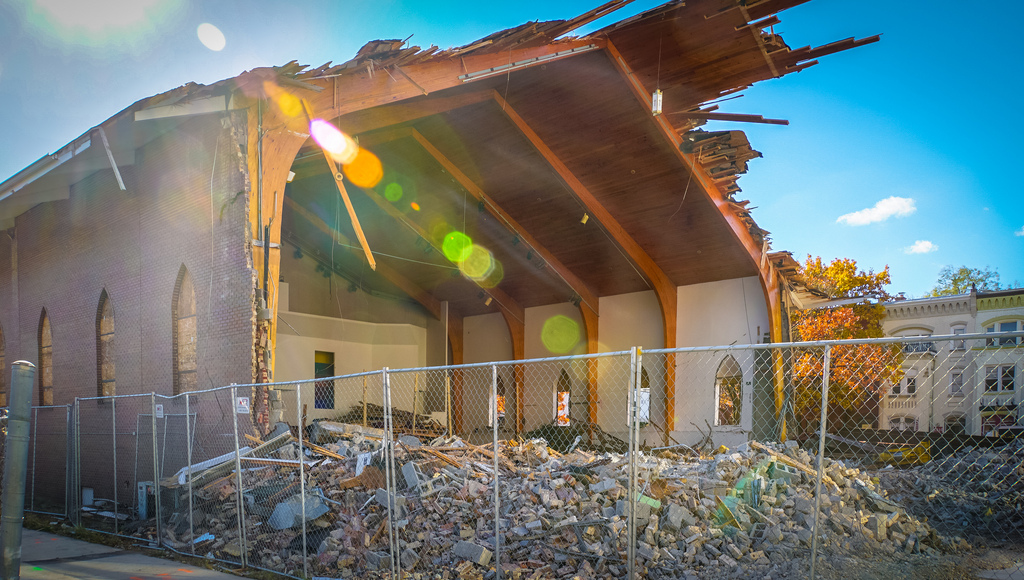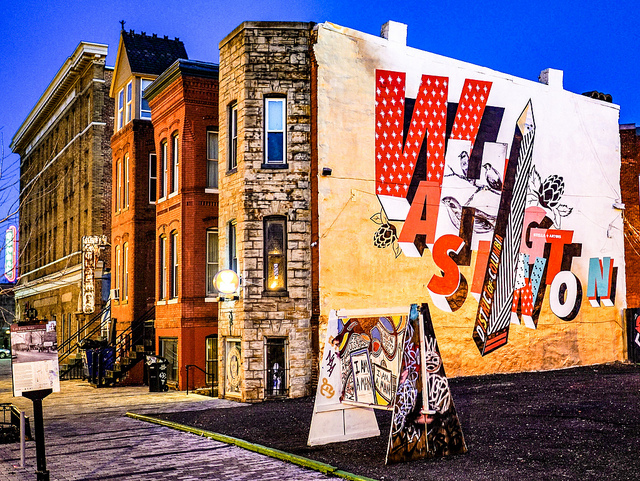City Observatory has long challenged the popular narrative about the nature and effects of gentrification. This is the second installment of a three-part commentary by our friend and colleague Alex Baca. You can read parts one and three as well. Alex has worked in journalism, bike advocacy, architecture, construction, and transportation in D.C., San Francisco, and Cleveland. She’s written about all of the above for Washington City Paper, CityLab, Slate, The American Conservative, Cleveland Magazine, Strong Towns, and Greater Greater Washington.
This week, City Observatory is addressing, in a series of posts, how Derek Hyra’s Race, Class, and Politics in the Cappuccino City doesn’t stick its landing. This second installment critiques Hyra’s ethnographic process and his references to other scholars who have addressed through their work the effects of upscaling neighborhoods on longtime residents. Part one appears here.
Ethnography In the Gentrification Canon
Shaw is a relatively dense, transit-rich neighborhood within walking distance of D.C.’s downtown, and it has been upscaling for over two decades. Hyra began his work there in 2010, though he did not release his book until last year. Of his intent with Cappuccino City, he writes:
“This book sets out to answer four questions. First, what broader political and economic dynamics relate to the transformation of the dark ghetto into the gilded ghetto? Second, what attracts some White residents to historic yet low-income urban African American neighborhoods? Third, what happens when people who have been segregated for so long come together in a diverse neighborhood? Lastly, how are low-income people benefiting when more affluent people move near them?”
Cappuccino City is not unlike The New Urban Renewal, Hyra’s first book. In each, he uses an ethnographic approach to frame the exploitation of black culture, in notable black neighborhoods, for the purposes of creating a marketable identity that appeals to newcomers; heavily references Saskia Sassen’s work to illustrate the impact of global forces on individual neighborhoods; and extensively documents community-meeting minutiae to illustrate the push and pull of neighborhood factions. In each, his hall pass into key non-white spaces is a black friend that brings him, most often, onto a neighborhood basketball court—or, as Hyra calls these acquaintances, “Docs,” in reference to William F. Whyte’s Street Corner Society (15).

And in each, Hyra writes about gentrification without actually writing about the structural reasons why housing in neighborhoods like Shaw has become so expensive. Peel back Cappuccino City’s conspicuous-consumption arguments—that affluent white people are so attracted to black culture that they’ll move for even a contrived facsimile of it, and will do so in great enough volumes to shift neighborhood demographics—and there’s no discussion of supply and demand, zoning, geography, or transportation. Further, despite Hyra’s talk of global influences, his Shaw functions in a vacuum: He does not address how whiter, more affluent neighborhoods in D.C. and the region have hoarded their wealth, and perpetuated gentrification in other neighborhoods, by attempting to block nearly any new development. Falls Church, Hyra’s place of residence, is an apt example of a place with policies that reinforce regional unaffordability over time: There, multi-family housing over three stories requires a special-use permit, which excludes people who can’t or don’t want to live in single-family homes and restricts supply in a relatively transit-rich municipality. Falls Church is more expensive than it could be because of policies like this; as a result of multiple Falls Churches choosing to be more expensive than they could be through their zoning codes, the D.C. region is constricted and pricier, too.
Hyra’s second claim, after creating a new academic framework for gentrification, is that he is posing questions that have been heretofore unexamined: “While the gentrification literature importantly examines whether residential displacement occurs alongside redevelopment, this book redirects the focus to whether low-income people who are able to stay benefit in meaningful ways.” However, he cites a number of authors whose work is concerned with the effects of upscaling neighborhoods on residents who have lived in those neighborhoods for some time. His notes show a great debt to Japonica K. Brown-Saracino, Brett Williams, and Gabriella Modan, who in A Neighborhood That Never Changes, Upscaling Downtown, and Turf Wars execute exactly what Hyra calls a new paradigm. Each are explicitly clear that what their subjects tell them is site-specific, often inconclusive, and not to be taken as a broad referendum on gentrification.
Hyra makes no such distinction. He orients his conclusions about Shaw as far-reaching, writing in his first chapter, “This pattern of central city redevelopment, driven largely by a White influx, and increasing minority and poverty presence in the inner suburbs is not unique to D.C. The cappuccino lens provides an urban account that not only helps to understand Washington, D.C., and its Shaw/U Street neighborhood but highlights community processes and outcomes likely occurring in other advanced service-sector cities, such as New York City, Atlanta, New Orleans, and Houston” (20). Similarly, The New Urban Renewal is billed on Hyra’s website as “offer[ing] an unparalleled analysis of the nation’s most difficult and complex issues.”
In service of this extrapolation, Cappuccino City blares statements such as, “Some newcomers to redeveloping ghettos who might be inspired by and appreciate elements of Black culture do not truly engage in the ghettos’ complexity. The younger newcomers, the tourists in place, seem more concerned with consuming ghetto-inspired culture than connecting and identifying with those struggling with the ills of racism and structural inequality” (101). The commodification of black culture—the undercurrent of nearly all of what we consume—is absolutely relevant to an academic consideration of Shaw. “Living the wire” and “black branding” clearly convey the frustrating-at-best, harmful-at-worst appropriation that’s been noticeable in D.C. and elsewhere for years.
But Hyra hews to these theses despite his white-newcomer subjects tell him directly that they’ve chosen to live in Shaw because of its close proximity to where they need to go: “Paul, a recent arrival, explains, ‘A large part of the reason I moved to Shaw and pay D.C.’s higher taxes was because of the ability to bike or walk to work” (129). That people will move as close to the things that matter to them as they can reasonably afford, that those with relative financial or social capital will have an easier time of this, and that those with relative financial or social capital are often white is not as interesting as “living the wire.” It is, however, the more likely culprit of neighborhood change.

Anyone on a local listserv, NextDoor, or Facebook group knows how easy it is to find someone willing to bemoan changes in their neighborhood. Likewise, it’s just as easy to find a character whose opinions about existing residents are irritating at best, and bigoted at worst. But drawing conclusions from bombastic stories, like the lurid retelling of a “hood party”, is not randomly selected or representative. Cappuccino City doesn’t consider a control group, selection bias, or comparative analysis. Hyra does not examine other neighborhoods within D.C. or outside of it, much less ask long-term residents in neighborhoods other than Shaw how they view change. If he had, he may have found that in some places, there are few “oldtimers” left behind to interrogate: Very poor neighborhoods that don’t rebound, or “gentrify,” are much more common than gentrifying neighborhoods, and essentially hemorrhage residents. As City Observatory’s Lost In Place report found in 2014:
“While media attention often focuses on those few places that are witnessing a transformation, there are two more potent and less mentioned storylines. The first is the persistence of chronic poverty. Three-quarters of 1970 high-poverty urban neighborhoods in the U.S. are still poor today. The second is the spread of concentrated poverty: Three times as many urban neighborhoods have poverty rates exceeding 30 percent as was true in 1970 and the number of poor people living in these neighborhoods has doubled.
The result of these trends is that the poor in the nation’s metropolitan areas are increasingly segregated into neighborhoods of concentrated poverty. In 1970, 28 percent of the urban poor lived in a neighborhood with a poverty rate of 30 percent or more; by 2010, 39 percent of the urban poor lived in such high-poverty neighborhoods.”
Cappuccino City’s exclusion of such findings could be unremarkable. The D.C. region is one of a handful in America facing an across-the-board housing crunch, so the idea that Hyra should conduct research in neighborhood that “hasn’t gentrified” so as to compare to Shaw might be laughable to some. But despite spending a great deal of his introduction extolling that D.C. is exceptional, Hyra ultimately claims that his theories, terminologies, and frameworks have far-reaching application. In addition to this misguided claim, Hyra retreads well-laid lines of academic thought, with faulty steps, rather than providing new insights: His fetishization of “living the wire” and “black branding” ignores what his subjects tell him to present a marketable narrative about gentrification.
